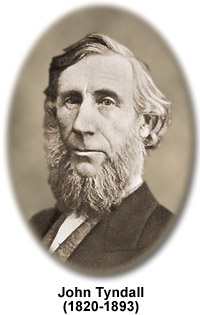John Tyndall
(1820-1893)

From a humble background, John Tyndall rose to great heights, becoming one of the most eminent men of science during his period. The self-made man was a powerful lecturer and an influential writer who published on topics ranging from molecular physics and magnetism to mountaineering, literature, religion, and the motion of glaciers. In optics, he is most famous for his discovery of the phenomenon that came to be known as the Tyndall effect.
Tyndall was born August 2, 1820 in County Carlow, Ireland to a family of limited means. His father, however, ensured that he received a solid elementary education. In 1839, he began working as a surveyor, first in Ireland and then in England, and reportedly attended lectures at a mechanical institute. For a brief period, in 1844, Tyndall became a railway engineer, and a few years later a teacher at Queenwood College. By 1848, he decided with much determination to obtain his doctorate degree, despite the financial strain it would cause him. Tyndall enrolled at the University of Marburg and received his degree two years later. Despite his credentials, however, Tyndall at first had difficulty in obtaining an academic post. Finally, in 1853, after he had gained some notoriety for experiments in magnetism and been appointed a fellow of the Royal Society, Tyndall was offered a position as a professor of natural philosophy at Londonís Royal Institution, which he eagerly accepted. There he was a colleague of Michael Faraday, whom he came to greatly esteem and would eventually memorialize in writing in the work Faraday as a Discoverer (1868). Tyndall was also acquainted with the English biologist Thomas H. Huxley, a good friend with whom he coauthored a treatise on glaciers after the pair went on a famous expedition to Switzerland in 1856.
Throughout the 1860s, much of Tyndallís time was spent studying the capacity of various gases and vapors to transmit and absorb radiant heat. In the course of these investigations, he built the first ratio spectrophotometer, an instrument that facilitates the measurement of absorption, and made numerous discoveries. For example, finding that water vapor, carbon dioxide, and ozone are the best absorbers of heat radiation, Tyndall determined that the substances are extremely important in maintaining the surface temperature of the Earth and that fluctuations in their levels in the atmosphere could lead to climate change. He also correctly attributed the formation of dew and frost to heat loss related to radiative processes and argued that London was a ďheat islandĒ that was warmer than neighboring areas. These and other findings related to his work on radiant heat were included in Heat as a Mode of Motion (1863) and On Radiation (1865).
The nature of light appears to have become of significant interest to Tyndall in the late 1860s, and a book he wrote on the topic was released in 1870. In 1869, he discovered the phenomenon that he is most famous for in the world of optics. While carrying out observations of solutions and colloids, Tyndall noted that a beam of light passing through a colloidal suspension is visible, but cannot be seen when it passes through a solution or a pure substance. As deduced by Tyndall, this phenomenon is due to the fact that in a colloidal suspension light is scattered by the many small particles it contains, but which are absent in homogenous mixtures and pure substances. Moreover, as also purported by Tyndall, this special instance of diffraction, now known as the Tyndall effect, results in the visualization of a blue or violet color when the particles present are very small, but will cause the color red to appear when the particles are larger in size. Oftentimes the Tyndall effect is used to determine the existence of a colloid and is observable in colloidal suspensions as weak as 0.1 parts per million.
As an extension of his work with colloids and light, Tyndall carried out experiments on optically pure air, confirming that organic matter is not decomposed by germ-free air and, therefore, providing additional support for the argument against sponatneous generation. Tyndall also devised experiments on total internal reflection and foresaw that fiber optics would eventually be used for communications. Later in his career, Tyndallís studies became more focused on sound and he published works in this area as well. From 1872 to 1873, his fame became even greater as he visited America and embarked upon a very well received lecture tour. Instead of accepting the significant amount of money gained by this venture for himself, Tyndall transferred the funds to trustees for the advancement of science in America, a testimony to his magnanimous character. However, despite such noble acts, Tyndall did occasionally find himself embroiled in controversy, especially when he gave his infamous Belfast address as president of the British Association for the Advancement of Science in 1874, in which he suggested that cosmology was a subject in the realm of science and not theology. Yet, generally John Tyndall was one of the most respected and well-known scientists of the nineteenth century and can be credited with bringing physical science to the common man and changing popular attitudes toward the subject.
